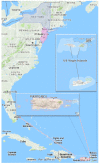Climate Change and Schools: Environmental Hazards and Resiliency
- PMID: 29144432
- PMCID: PMC5708036
- DOI: 10.3390/ijerph14111397
Climate Change and Schools: Environmental Hazards and Resiliency
Abstract
The changing climate is creating additional challenges in maintaining a healthy school environment in the United States (U.S.) where over 50 million people, mostly children, spend approximately a third of their waking hours. Chronic low prioritization of funds and resources to support environmental health in schools and lack of clear regulatory oversight in the U.S. undergird the new risks from climate change. We illustrate the extent of risk and the variation in vulnerability by geographic region, in the context of sparse systematically collected and comparable data particularly about school infrastructure. Additionally, we frame different resilience building initiatives, focusing on interventions that target root causes, or social determinants of health. Disaster response and recovery are also framed as resilience building efforts. Examples from U.S. Federal Region 2 (New Jersey, New York, Puerto Rico, and the U.S. Virgin Islands) and nationally are used to illustrate these concepts. We conclude that better surveillance, more research, and increased federal and state oversight of environmental factors in schools (specific to climate risks) is necessary, as exposures result in short- and long term negative health effects and climate change risks will increase over time.
Keywords: adaptation; built environment; children; disaster preparedness; environmental health; health effects of climate change; mitigation; school environment; students; vulnerability.
Conflict of interest statement
The authors declare no conflict of interest.
Figures



Similar articles
-
Children's environmental health and disaster resilience in Puerto Rico and the U.S. Virgin Islands.Appl Nurs Res. 2022 Aug;66:151482. doi: 10.1016/j.apnr.2021.151482. Epub 2021 Aug 8. Appl Nurs Res. 2022. PMID: 34602323 Free PMC article.
-
Climate Change and Schools: Implications for Children's Health and Safety.Creat Nurs. 2019 Aug 15;25(3):249-257. doi: 10.1891/1078-4535.25.3.249. Creat Nurs. 2019. PMID: 31427421
-
Beyond the Hazard Vulnerability Analysis: Preparing Health Systems for Climate Change.R I Med J (2013). 2021 Nov 1;104(9):55-59. R I Med J (2013). 2021. PMID: 34705910
-
The Minderoo-Monaco Commission on Plastics and Human Health.Ann Glob Health. 2023 Mar 21;89(1):23. doi: 10.5334/aogh.4056. eCollection 2023. Ann Glob Health. 2023. PMID: 36969097 Free PMC article. Review.
-
A Comparative Analysis of Climate-Risk and Extreme Event-Related Impacts on Well-Being and Health: Policy Implications.Int J Environ Res Public Health. 2018 Feb 13;15(2):331. doi: 10.3390/ijerph15020331. Int J Environ Res Public Health. 2018. PMID: 29438345 Free PMC article. Review.
Cited by
-
New York State Climate Impacts Assessment Chapter 04: Buildings.Ann N Y Acad Sci. 2024 Dec;1542(1):214-252. doi: 10.1111/nyas.15200. Epub 2024 Dec 9. Ann N Y Acad Sci. 2024. PMID: 39652388 Free PMC article.
-
Teaching, Learning, and Climate Change: Anticipated Impacts and Mitigation Strategies for Educators.Behav Soc Issues. 2023 May 12:1-23. doi: 10.1007/s42822-023-00129-2. Online ahead of print. Behav Soc Issues. 2023. PMID: 38625183 Free PMC article.
References
-
- Glander M. Selected Statistics from the Pubic Elementary and Secondary Education Universe: School Year 2014–2015. U.S. Department of Education, National Center for Education Statistics; Washington, DC, USA: 2016.
-
- Bush M., Ryan M., Rose S. School Calender: Length of School Year. Educational Commission of the States; Denver, CO, USA: 2011.
-
- National Center for Education Statistics Elementary and Secondary Enrollment. The Condition of Education. [(accessed on 18 September 2017)];2017 Available online: https://nces.ed.gov/programs/coe/indicator_cga.asp.
-
- Coalition for Healthier Schools Special Issues: Climate Change. Towards Healthy Schools: Reducing Risks to Children. Healthy Schools Network: Albany, KY, USA, 2016; 50–53. [(accessed on 24 September 2017)]; Available online: http://www.healthyschools.org/documents/TowardsHealthySchools-Risks.pdf.
MeSH terms
Grants and funding
LinkOut - more resources
Full Text Sources
Other Literature Sources
Medical

